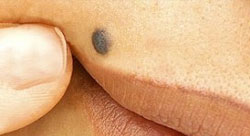Before making the decision to have a mole removal procedure done you must first understand what it consists of, the risks associated with it and whether it’s deemed necessary by a licensed dermatologist. Countless people have moles on their face. A lot of times it can cause feelings of social rejection. This is among the main reasons why people decide to remove their moles. If removal is for cosmetic reasons or not, it’s recommended that you educate yourself on the risks that come along with the procedure. You should also visit your physician in order to discuss options based on your medical history, and then decide which procedure fits you best.

Life Cycle of a Mole
Perhaps you have noticed that young children barely have moles. This is because the life cycle of a mole coincidentally goes in sync with a person’s lifespan. Most newborn babies don’t have any type of visible moles (although there might birthmarks), yet with time they will start to appear. Moles, as you probably have seen, can vary in size. As a person starts getting older and has been naturally exposure to the sun for a while, moles start to appear. The majority of moles are harmless and might even go away on their own over the years. While new moles usually don’t grow after the age of fifty, it is entirely possible that a malignant growth could form and look like a mole at an older age. Check with a dermatologist every time you find new bumps or growths on your skin.
Benign or Malignant?
One of the main reasons why it’s advisable to obtain medical advice prior to having a mole removal procedure done is because your mole might be malignant. Most of the moles that appear on people’s skin are benign and harmless, however, there is a percentage of all moles that carry cancer. Pay attention to characteristics that may help you differentiate a benign mole from a malignant mole. For example, most benign moles are usually oval-shaped, they’re one single color and they’re well proportioned. On the opposite end, malignant moles tend to change colors or show up in two different colors. Those that are larger moles that seem to get larger by the day are potentially malignant. The best way to go about deciding on a mole removal procedure is by obtaining medical advice.
Mole Removal Preparation
If you have already visited your private physician and have gone through their different recommendations and risks, then you should then move forward with your mole removal procedure. On the day of the procedure you can expect a surgeon to clean the area thoroughly. This might be done with alcohol or with a type of iodine, topical antiseptic. After this has been done, the surgeon will continue to apply local anesthesia, (at this point the doctor will know for sure that you’re not allergic). After the effect has kicked in, the surgeon will proceed to remove the mole using the agreed technique.
